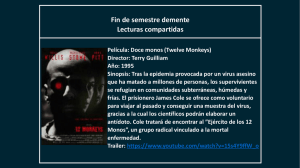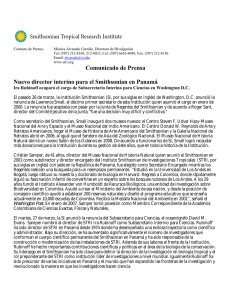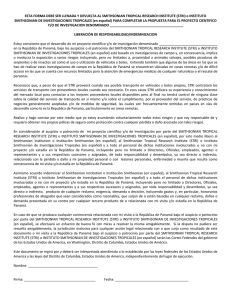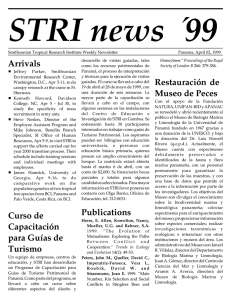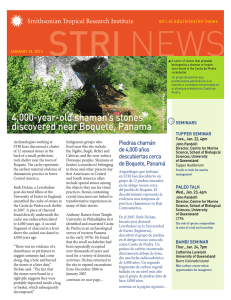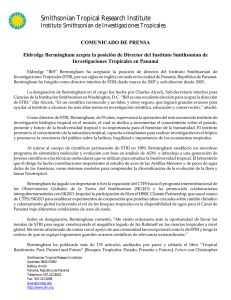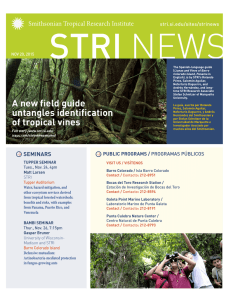monkey movements explained by forest structure in panama
Anuncio
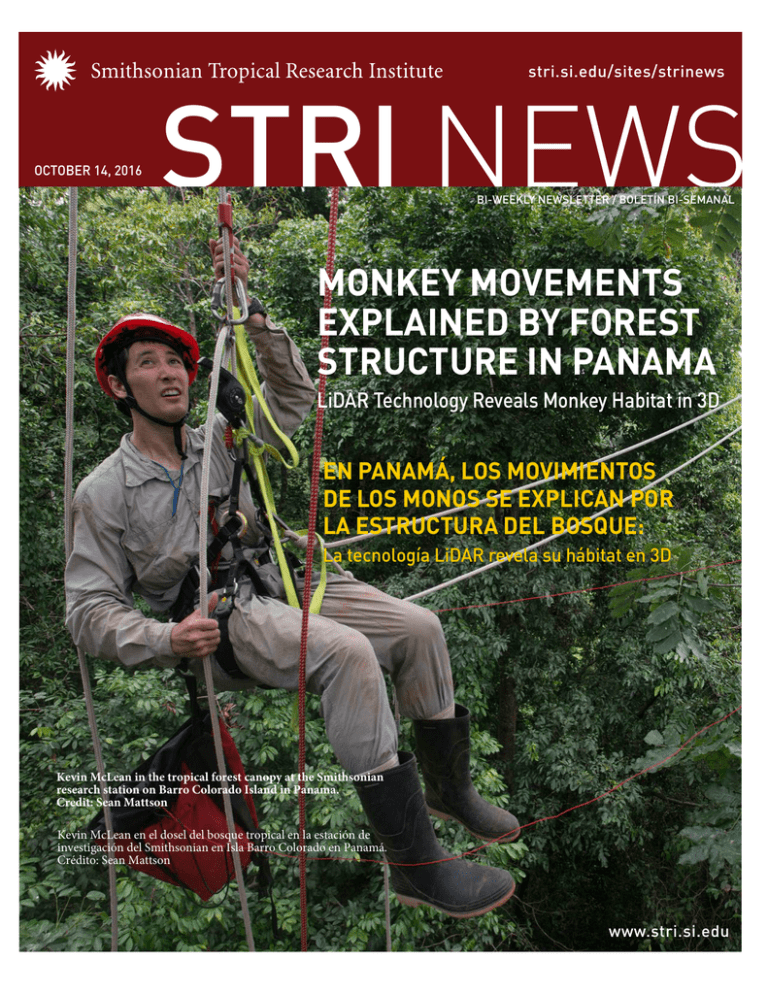
STRI NEWS stri.si.edu/sites/strinews OCTOBER 14, 2016 BI-WEEKLY NEWSLETTER / BOLETÍN BI-SEMANAL MONKEY MOVEMENTS EXPLAINED BY FOREST STRUCTURE IN PANAMA LiDAR Technology Reveals Monkey Habitat in 3D EN PANAMÁ, LOS MOVIMIENTOS DE LOS MONOS SE EXPLICAN POR LA ESTRUCTURA DEL BOSQUE: La tecnología LiDAR revela su hábitat en 3D Kevin McLean in the tropical forest canopy at the Smithsonian research station on Barro Colorado Island in Panama. Credit: Sean Mattson Kevin McLean en el dosel del bosque tropical en la estación de investigación del Smithsonian en Isla Barro Colorado en Panamá. Crédito: Sean Mattson www.stri.si.edu White-faced capuchin monkey | Mono capuchino cariblanco Credit | Crédito: Sean Mattson Front cover photo by | Foto de portada por: Sean Mattson Monkey Movements Explained by Forest Structure In Panama LiDAR Technology Reveals Monkey Habitat in 3D En Panamá, los movimientos de los monos se explican por la estructura del bosque: La tecnología LiDAR revela su hábitat en 3D Why are monkeys smart? Some say it is because they make mental maps for efficiently travelling through the forest canopy from one fruiting tree to the next. Kevin McLean, former fellow at the Smithsonian Tropical Research Institute, and colleagues successfully used LiDAR (light detection and radar) technology to map the tropical forest canopy on Barro Colorado Island in Panama and to predict the movements of three monkey species. “Everyone visiting a tropical forest wants to see monkeys,” said Patrick Jansen, staff scientist at STRI. “In addition to attracting tourists, monkeys play important roles in the forest as they disperse seeds. Kevin’s work helps us to predict how monkeys are affected when the forest canopy is disturbed by human activities such as logging and road building.” To create three-dimensional maps of the tropical forest canopy on the entire island, a team from the Carnegie Institution for Science flew over the forest in a plane equipped with airborne LiDAR equipment. Based on the map they were able to estimate, at different points in ¿Por qué son inteligentes monos? Algunos dicen que es porque hacen mapas mentales para viajar de manera eficiente a través del dosel del bosque de un árbol frutal al siguiente. Kevin McLean, ex becario del Instituto Smithsonian de Investigaciones Tropicales (STRI), y sus colegas utilizaron con éxito la tecnología de detección y medición aérea LiDAR para mapear el dosel del bosque tropical en la Isla Barro Colorado en Panamá y para predecir los movimientos de tres especies de monos. “Cualquiera que visite una selva tropical quiere ver monos,” comentó Patrick Jansen, científico de STRI. “Además de atraer a los turistas, los monos juegan un papel importante en el bosque, ya que dispersan las semillas. El trabajo de Kevin nos ayuda a predecir cómo se ven afectados los monos cuando el dosel del bosque es perturbado por actividades humanas como la tala y la construcción de carreteras”. Para crear mapas tridimensionales de la cubierta forestal tropical en toda la isla, un equipo del Carnegie Institution for Science voló sobre el bosque en un avión equipado con el equipo LIDAR. Basados en el mapa, fueron capaces OCTOBER 14, 2016 / p. 2 the forest, how mature the trees were, whether a monkey would be able to jump from one branch to the next (lateral connectivity) and whether there would be something to land on if it did (substrate availability). McLean, as part of his doctorate at the Yale School of Forestry, used GPS tracking data on three monkey species to determine which canopy properties best explained the movements. Meg Crofoot, research associate at STRI and assistant professor at the University of California at Davis, offered GPS location data from a high-ranking female white-faced capuchin monkey (Cebus capuchinus). Christina Campbell, professor at California State University, provided GPS tracking data for black-handed spider monkeys (Ateles geoffroyi). Mariah Hopkins from the University of Texas at Austin contributed movement data for mantled howler monkeys (Alouatta palliata). The three monkey species moved in very different ways. Capuchins and spider monkeys that eat a high-energy omnivorous diet of fruit, bird and reptile eggs, small animals and insects moved quickly through the forest—at almost 5 meters per minute. Howler monkeys eat mostly leaves. As a result of their low-energy diet, they usually move more slowly, only about 3 meters per minute on average. Capuchins moved farthest every day, more than 3,000 meters; whereas spider monkeys moved only 2,500 meters and howler monkeys just over 400 meters. Spider monkeys moved all around the island, whereas capuchins and howler monkeys stayed in smaller areas. McLean found that spider and capuchin monkeys preferred the taller trees characteristic of mature tropical forest. In fact, spider monkeys seem to stick to certain routes through the forest. They may need mature, thick-canopied forest in order to take advantage of their ability to swing through the trees. The factor most important in predicting howler monkey movement in a mature forest area on Barro Colorado Island was canopy connectivity at 10–20 meters above the forest floor. McLean will continue his work to understand and protect canopy mammals by camera-trapping in large-scale forest monitoring plots in Ecuador and Malaysia, both parts of the Smithsonian’s Forest Global Earth Observatory network of 64 forests in 25 countries. You will hear more from McLean soon, as he also received a FulbrightNational Geographic Digital Storytelling Fellowship in July. de estimar en diferentes puntos de la selva, la madurez de los árboles, si un mono sería capaz de saltar de una rama a la siguiente (la conectividad lateral) y si lo hiciera, si habría algo en donde pueda caer (disponibilidad de sustrato). McLean, como parte de su doctorado en la Yale School of Forestry, utiliza los datos de localización GPS en tres especies de monos para determinar qué propiedades del dosel explican mejor los movimientos. Meg Crofoot, investigadora asociada de STRI y profesora asistente en la Universidad de California en Davis, ofreció datos de localización GPS de un mono capuchino hembra de alto rango (Cebus capuchinus). Christina Campbell, profesora de la Universidad del Estado de California, brindó datos de localización GPS de monos araña de manos negras (Ateles geoffroyi). Mariah Hopkins de la Universidad de Texas en Austin aportó datos sobre el movimiento de los monos aulladores (Alouatta palliata). Las tres especies de monos se movieron de manera muy diferente. Los monos capuchinos y los monos araña que se alimentan de una dieta omnívora de alta energía de huevos, de frutas, de huevos de aves y reptiles, pequeños animales e insectos, se movieron rápidamente a través del bosque a casi 5 metros por minuto. Los monos aulladores se alimentan principalmente de hojas. Como resultado de su dieta baja en energía, por lo general se mueven más lentamente, en promedio de sólo unos 3 metros por minuto. Los Capuchinos se trasladaron todos los días cada vez más lejos, más de 3,000 metros; mientras que los monos araña se movieron solamente 2,500 metros y los monos aulladores poco más de 400 metros. Los monos araña se movían por toda la isla, mientras que los capuchinos y los monos aulladores se quedaron en áreas más pequeñas. McLean encontró que los monos araña y capuchinos prefieren los árboles más altos, característicos de los bosques tropicales maduros. De hecho, los monos araña parecen atenerse a ciertas rutas por el bosque. Es posible que necesiten bosques maduros, de con dosel espeso, con el fin de aprovechar su capacidad de balancearse a través de los árboles. El factor más importante para predecir el movimiento de los monos aulladores en una zona de bosque maduro en la Isla de Barro Colorado, fue cubierta a una conectividad 10-20 metros por encima del suelo del bosque. McLean continuará su trabajo para comprender y proteger a los mamíferos del dosel por medio de cámaras OCTOBER 14, 2016 / p. 3 trampa colocadas en parcelas de monitoreo forestal a gran escala en Ecuador y Malasia, ambas parte de la Red Observatorios Mundiales de Bosques del Smithsonian, una red de 64 bosques en 25 países. Pronto sabrán más de McLean, ya que en julio también recibió una beca Fulbright-National Geographic Digital Storytelling. 2016. Movement patterns of three arboreal primates in a Neotropical moist forest explained by LiDAR-estimated canopy structure. Landscape Ecology 31:1849-1862 doi10.1007/ s10980-016-0367-9 The BioMuseo recently celebrated its second anniversary with a Rediscovering Our History event in which Richard Cooke, STRI archaeologist, and STRI researcher Nicole Smith-Guzman shared their artifacts with visitors and answered their questions. El BioMuseo recientemente celebró su segundo aniversario con el evento Redescubriendo Nuestra Historia donde Richard Cooke, arqueólogo de STRI y la investigadora de STRI Nicole Smith-Guzman compartieron sus artefactos con los visitantes y contestaron sus interrogantes. OCTOBER 14,, 2016 / p. 4 La Consejera Kristie Kenney del Departamento de Estado de EE.UU. visita ¡CHISPA! U.S. State Department Counselor Kristie Kenney Visits CHISPA! On October 6, Ambassador Kristie Kenney, Counselor of the U.S. State Department, stopped by to visit CHISPA!—an after-school science mentoring program for at-risk youth, which takes place at Punta Culebra Nature Center. “You’re preparing the scientists of the future here,” said Counselor Kenney during a Facebook LIVE interview hosted by Punta Culebra supervisor, Jimena Pitty, and Maria Fernanda Vinasco, CHISPA! project coordinator. CHISPA connects young people from Panama’s San Felipe, Santa Ana, Chorrillo, Barraza and Curundú neighborhoods with Smithsonian scientists and educators who provide them with an often transformational foray into their curiosity-inspired research projects, encouraging them to develop critical thinking, communication and teamwork skills. The program, started as a pilot project in 2012 by STRI’s public programs director Sharon Ryan with a twoyear grant from Banistmo bank, is now in its fourth year and is currently supported by a grant from the U.S. State Department. Counselor Kenney, who speaks Spanish fluently, due, in part, to her previous role as U.S. Ambassador to Ecuador, was on her way through Panama after a visit to Peru. In Panama she also met with Vice President, Isabel Saint Malo and other senior government officials to discuss priorities in U.S.-Panama bilateral relations and areas of global cooperation. She also visited the newly opened third set of locks on the Panama Canal, met with representatives of the business community and members of civil society. El 6 de octubre, la Embajadora Kristie Kenney, Consejera del Departamento de Estado de EE.UU., visitó CHISPA! -un programa de tutorías en ciencias para después de clases dirigido a jóvenes en riesgo, que se lleva a cabo en el Centro Natural Punta Culebra. “Están preparando los científicos del futuro”, comentó la Consejera Kenney durante una entrevista en vivo por Facebook acogida por la supervisora de Punta Culebra, Jimena Pitty, y María Fernanda Vinasco, coordinadora del proyecto ¡CHISPA! ¡CHISPA! une a jóvenes panameños de los barrios de San Felipe, Santa Ana, El Chorrillo, Barraza y Curundú con científicos del Smithsonian y educadores que les proporcionan una incursión, con frecuencia transformadora, en sus proyectos de investigación, guiados por su propia curiosidad, animándoles a desarrollar habilidades críticas como el pensamiento, la comunicación y el trabajo en equipo. El programa, que inició como un proyecto piloto en el 2012 por la directora de programas públicos del Smithsonian Sharon Ryan con una subvención de dos años del banco Banistmo, ya cumple su cuarto año y actualmente es apoyado por una subvención del Departamento de Estado de los EE.UU.. Consejera Kenney, quien habla español con fluidez, debido, en parte, a su papel anterior como Embajadora de los EE.UU. en Ecuador, estaba de paso por Panamá después de una visita a Perú. En Panamá también se reunió con la vicepresidente, Isabel Saint Malo y otros altos funcionarios gubernamentales para discutir las prioridades en las relaciones bilaterales entre EE.UU. y Panamá además de áreas de cooperación global. Visitó también el tercer juego de esclusas del Canal de Panamá, recientemente inauguradas y se reunió con representantes de la comunidad de negocios y miembros de la sociedad civil. OCTOBER 14,, 2016 / p.5 Image courtesy of the Ministry of Environment of Panama | Imagen cortesía del Ministerio de Ambiente de Panamá Smithsonian participates in Matusagaratí protected area proposal review The Ministry of Environment of Panama (MiAMBIENTE) invited non-governmental organizations and civil institutions to review a proposal for a new protected area, Wetland Wildlife Refuge Matusagaratí, located in the districts of Chepigana and Pinogana in Panama’s Darien Province. The design of the 26,120 hectare reserve stipulates protection of a significant portion of the wetland including both sides of the Tuira River, which forms part of a complex ecosystem extending to the Filo del Tallo-Canglón and Chepigana forest reserves. There is also a plan to protect a significant area of mangroves further to the north. The public consultation process was opened by MiAMBIENTE on October 3 so that stakeholders could present their observations and comments between Oct. 3--31. The document is available on the website of the Ministry of Environment of Panama. Once the comments are compiled, a legal document establishing the protected area and also the official decree will be drafted. Smithsonian participa del proceso de propuesta de área protegida El Ministerio de Ambiente de Panamá (MiAMBIENTE) invitó a organizaciones no gubernamentales e instituciones civiles a participar en una consulta para recoger opiniones sobre la propuesta del área protegida Refugio de Vida Silvestre Humedal Matusagaratí, situado en el distrito de Chepigana y Pinogana en Darién. El diseño de la propuesta de 26,120 hectáreas contempla un plano más amplio protegiendo una porción importante del humedal que incluye ambos márgenes del río Tuira y, que forma parte de un complejo de ecosistemas que se extiende a la reserva forestal de Filo del Tallo-Canglón y la reserva forestal de Chepigana. También existe un plan para proteger una porción importante de manglares más al norte. El proceso de consulta pública fue abierto por MiAMBIENTE el 3 de octubre para que los interesados presentaran sus observaciones y comentarios del 3 al 31 de octubre. El documento está disponible en la página WEB del Ministerio de Ambiente de Panamá. Una vez se recopilen los criterios de los diferentes grupos, se consolidará un documento legal que establezca el área protegida para luego promulgar el decreto respectivo. OCTOBER 14,, 2016 / p. 6 From left to right Carlos Jaramillo, STRI Scientist, Matthew Larsen, STRI Director and Jefferson Hall, STRI Scientist | De izquierda a derecha Carlos Jaramillo, Científico de STRI, Matthew Larsen, Director de STRI y Jefferson Hall, Científico de STRI CONGRATULATIONS CARLOS JARAMILLO AND JEFF HALL! Dear Colleagues, I am pleased to announce the recipients of the 2016 Secretary’s Research Prizes. These pan-Institutional prizes recognize excellence in recent research by Smithsonian staff. The recipients are: Dr. Jefferson Hall of the Smithsonian Tropical Research Institute for his edited volume Managing Watersheds for Ecosystem Services in the Steepland Neotropics Dr. Carlos Jaramillo of the Smithsonian Tropical Research Institute for his co-authored article “Middle Miocene Closure of the Central American Seaway” published in Science The prizes include a $2,000 award to the prize winner’s research account. Finalists were recommended by a committee representing research areas across the spectrum of Smithsonian scholarship. I offer my congratulations to each of the recipients, and I hope you will join us for this celebration of scholarship at the Smithsonian. Sincerely, David Skorton, Secretary of the Smithsonian Institution The awards ceremony took place Wed., Sept. 14, in the Warner Bros. Theater at the National Museum of American History in Washington. FELICIDADES CARLOS JARAMILLO Y A JEFF HALL! Queridos colegas, Tengo el placer de anunciar los ganadores de los Premios de la Secretaría para la investigación del 2016. Estos premios pan-Institucionales reconocen la excelencia en la investigación reciente hecha por el personal del Smithsonian. Los galardonados son: El Dr. Jefferson Hall del Instituto Smithsonian de Investigaciones Tropicales por su volumen editado Gestión de las cuencas hidrográficas para los servicios ecosistémicos en laderas del neotrópico El Dr. Carlos Jaramillo, del Instituto Smithsonian de Investigaciones Tropicales por su co-autoría en el artículo “El cierre de la vía marítima de Centroamérica durante el Mioceno medio”, publicado en la revista Science. Los galardones incluyen un premio de $2,000 a la cuenta de investigación del ganador. Los finalistas fueron recomendados por un comité que representa a las áreas de investigación en todo el espectro de eruditos en el Smithsonian. Ofrezco mis felicitaciones a cada uno de los destinatarios, y espero que se unan a nosotros para esta celebración de la erudición en el Smithsonian. Sinceramente, David Skorton, Secretario de la Institución Smithsonian La entrega de premios tuvo lugar el miércoles, 14 de septiembre, en el Teatro Warner Bros. en el Museo Nacional de Historia Americana en Washington DC. OCTOBER 14, 2016 / p. 7 GRACIAS RICK CONDIT Al final del año fiscal 2016, el científico Richard Condit se retirará de STRI luego de casi 25 años de servicio a la Institución. Rick recibió su doctorado de la Universidad de California en San Diego por un estudio de la biología alimentaria del elefante marino del norte. THANK YOU RICK CONDIT At the end of fiscal year 2016, Staff Scientist Richard Condit will retire from STRI after nearly 25 years of service to the Institution. Rick received his doctorate from the University of California at San Diego for a study of the feeding biology of the northern elephant seal. Rick joined the STRI staff in 1991. He played an instrumental role in shaping the scientific direction of the Center for Tropical Forest Science as it grew from one 50-hectare long-term study site on Barro Colorado Island in Panama to a global network of more than 60 sites and became known as the Smithsonian’s Forest Global Earth Observatory (ForestGEO). He influenced countless researchers around the world by offering highly regarded courses in statistical methods for analyzing large forest dynamics data sets. Over the course of a productive career he received more than $4 million in external research grants, published more than 200 scientific books and articles and has produced important software and databases for the CTFS network. Among the books are Trees of Panama and Costa Rica (with Rolando Peréz and Nefertaris Daguerre, Princeton University Press), and Tropical Forest Census Plots: Methods and Results from Barro Colorado Island, Panama and a Comparison with Other Plots (Springer-Verlag, Berlin). Rick se unió al Smithsonian en 1991. Jugó un papel fundamental en la conformación de la dirección científica del Centro de Ciencias Forestales del Trópico (CTFS), a medida que pasó de ser un sitio de estudio de 50 hectáreas a largo plazo en la Isla Barro Colorado en Panamá, a una red global de más de 60 sitios, hoy como Observatorio Mundial de Bosques del Smithsonian (ForestGEO). Influyó a innumerables investigadores de todo el mundo, ofreciendo cursos de gran prestigio en los métodos estadísticos para el análisis de grandes conjuntos de datos de dinámica de bosques. En el transcurso de una carrera productiva recibió más de $4 millones en subvenciones para investigaciones externas, publicó más de 200 libros y artículos científicos y produjo software y bases de datos importantes para la red del CTFS. Entre los libros podemos mencionar Trees of Panama and Costa Rica (con Rolando Pérez y Nefertaris Daguerre, producido por la Princeton University Press), y Tropical Forest Census Plots: Methods and Results from Barro Colorado Island, Panama and a Comparison with Other Plots (Springer-Verlag, Berlín). La Oficina del Director da las gracias al Dr. Condit por sus muchas contribuciones científicas importantes y le desea lo mejor en todos sus esfuerzos. The Director’s Office thanks Dr. Condit for his many important scientific contributions and wishes him well in all his endeavors. OCTOBER 14, 2016 / p. 8 PUBLICATIONS | PUBLICACIONES Correa-Metrio, A., Vélez, M. I., Escobar, J., StJacques, J., López-Pérez, M., Curtis, J. and Cosford, J. 2016. Mid-elevation ecosystems of Panama: future uncertainties in light of past global climatic variability: A Thousand Years of Environmental Variability in Panama. Journal of Quaternary Science, doi:10.1002/ jqs.2899 Santos-Granero, F.. 2016. Masters, Slaves, and Real People: Native Understandings of Ownership and Humanness in Tropical American Capturing Societies. In: Brightman, Marc, Grotti, Vanessa and Fausto, Carlos, Ownership and Nurture: Studies in Native Amazonian Property Relations. London: Berghahn Books, pp.36-62. De Guzman, M. E., Santiago, L. S., Schnitzer, S. A. and Álvarez-Cansino, L. 2016. Trade-offs between water transport capacity and drought resistance in neotropical canopy liana and tree species. Tree physiology, doi:10.1093/treephys/ tpw086 Barrantes, G., Sánchez-Quirós, C., Aisenberg, A., Leitch, K. and Eberhard, W. G. 2015. Loss of Cheliceral Clasping in Leucauge sp. (Araneae, Tetragnathidae). Arachnology, 16(8): 281-286. doi:10.13156/ arac.2015.16.8.281 Gonzalez-Terrazas, T., Koblitz, J. C., Fleming, T. H., Medellín, R. A., Kalko, E. K. V., Schnitzler, H. and Tschapka, M. 2016. How NectarFeeding Bats Localize their Food: Echolocation Behavior of Leptonycteris yerbabuenae Approaching Cactus Flowers. PloS One, 11(9) doi:10.1371/journal.pone.0163492 Ewers, R. M., Andrade, A., Laurance, S. G., Camargo, J. L., Lovejoy, T. E. and Laurance, W. F. 2016. Predicted trajectories of tree community change in Amazonian rainforest fragments. Ecography, doi:10.1111/ecog.02585 Kapheim, K. M. 2016. Genomic sources of phenotypic novelty in the evolution of eusociality in insects. Current Opinion in Insect Science, 13: 24-32. doi:10.1016/j. cois.2015.10.009 Roberts, D. L. 2016. Two species of tanagers (Passeriformes: Thraupidae) forage on army ant workers ( Eciton burchellii ) carrying immature paper wasps. The Wilson Journal of Ornithology, 128(3): 653-656. doi:10.1676/1559-4491-128.3.653 ARRIVALS | LLEGADAS Grace Chen Misericordia University Effects of Periodic Water Availability on Delayed Seed Germination in Neotropical Costus Species Gamboa Dalia Barragán Universidad de los Andes, Colombia Estructura y diversidad genética del delfín nariz de botella Tursiops truncatus (Montagu, 1821) (cetacea: delphinidae) en Bocas del Toro, costa Caribe de Panamá Bocas del Toro Patricia Corro Universidad de Panamá STRI Insect Collection Tupper Flórez, P., Zapata A., Jaramillo, C. and James, S. K. 2016. Early to Middle Miocene shallowwater corals from La Guajira, Colombia. doi:10.7287/peerj.preprints.2507v1 Spiegel, O.and Crofoot, M. C. 2016. The feedback between where we go and what we know— information shapes movement, but movement also impacts information acquisition.Current Opinion in Behavioral Sciences, 12: 90-96. doi:10.1016/j.cobeha.2016.09.009 Yang, Y., Richards-Zawacki, C., Devar, A. and Dugas, M. B. 2016. Poison frog color morphs express assortative mate preferences in allopatry but not sympatry.Evolution; international journal of organic evolution, doi:10.1111/evo.13079 Jamangapé O, José A., Velázquez-Velázquez, E., Martínez-Ramirez, E., Anzueto-Calvo, M., Gomez, E. L., Dominguez-Cisneros, S., Mcmahan, C. D. and Matamoros, W. A. 2016. Validity and Redescription of Profundulus balsanus Ahl, 1935 (Cyprinodontiformes: Profundulidae). Zootaxa, 4173(1): 55-65. Khadempour, L., Burnum-Johnson, K., Baker, E. S., Nicora, C. D., Webb-Robertson, B., White, R. A., Monroe, M. E., Huang, E.L., Smith, R. D. and Currie, C. R. 2016. The fungal cultivar of leaf-cutter ants produces specific enzymes in response to different plant substrates. Molecular ecology, doi:10.1111/ mec.13872 DEPARTURES | SALIDAS Ira Rubinoff To Washington DC For official meetings To Gainesville, Florida To give seminar at the University of Florida Biology Department, and meetings Juan Maté To Santiago Veraguas For a presentation about Coiba National Park Rigoberto Díaz To Donoso, Colón Province To collect 4 target species of amphibians for our ex-situ conservation program Héctor Guzán To Costa Rica, San José For meetings Rachel Page To Baltimore, San Antonio, Austin To meet with colleagues to discuss joint Human Frontier Science Program grant Rachel Collin To Bocas del Toro To oversee Bocas station administration Helene Muller OCTOBER 14, 2016 / p. 9 SEMINARS | SEMINARIOS TUPPER SEMINAR Tue., Oct. 18, 4pm John Smol Queen’s University, Kingston, Canada Tupper Auditorium Lakes, climatic change, and multiple environmental stressors: Using the past to help prepare for the future TUPPER SEMINAR Tue., Oct. 25, 4pm Keith Clay, Indiana University Tupper Auditorium TBA PALEOTALK Wed. Oct. 19, 4pm Mark Brenner University of Florida, Geological Sciences & Land Use and Environmental Change Institute CTPA Paleoclimate and Paleoenvironment of the Lowland Maya Region, Late Pleistocene to Present GET IN TOUCH! WE’D LOVE TO KNOW WHAT YOU THINK ¡CONTÁCTANOS! NOS ENCANTARÍA SABER SU OPINIÓN: SAVE THE DATE Oct. 26-27 Microbial Ecology Science Symposium Tupper Center OCTOBER 14, 2016 / p. 10 OCTOBER 14, 2016 / p. 11 OCTOBER 14, 2016 / p. 12 OCTOBER 14,, 2016 / p. 12
